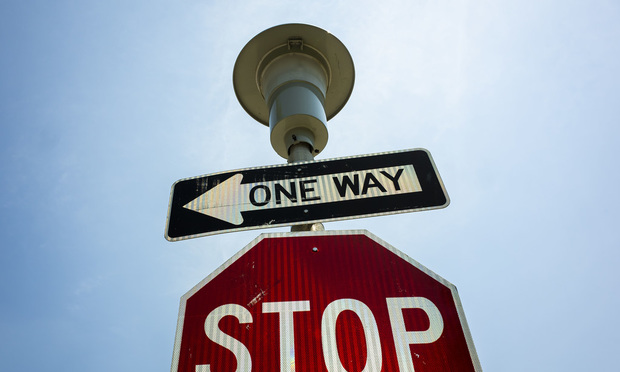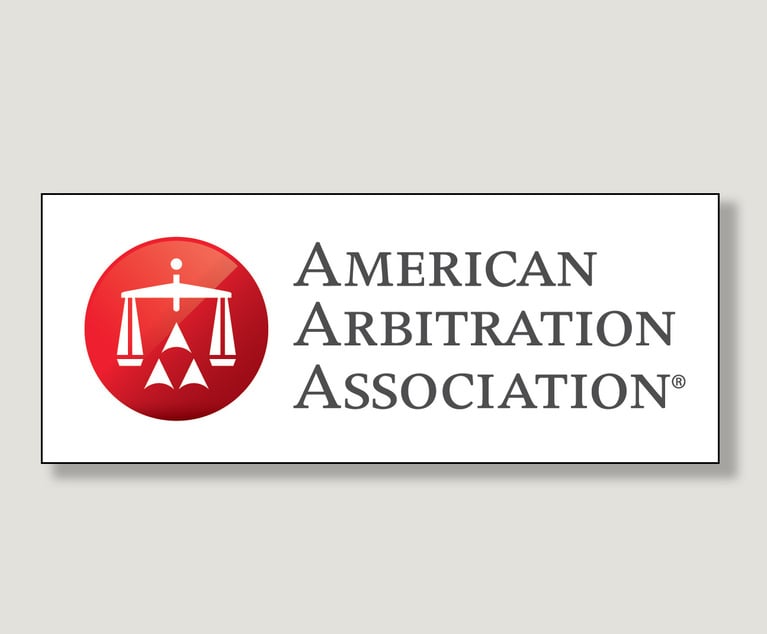Offer of Judgment: End the One-Way Street for Personal Injury Plaintiffs
One would think that any rule in the courts should always apply to both parties fairly. However upon closer examination, the OOJ Rule contains key phrases that benefit only the person suing for money.
July 22, 2020 at 12:00 PM
9 minute read
 Photo: Diego M. Radzinschi/ALM
Photo: Diego M. Radzinschi/ALM
Some offers are too good to be true; others are hard to refuse. Yet when it comes to personal injury claims, medical malpractice litigation and potentially frivolous lawsuits, which have large potential awards with flimsy theories of negligence, Rule 4:48 or the New Jersey Offer of Judgment Rule (the "OOJ Rule") is a one-sided tool in favor of plaintiffs. One would think that any rule in the courts should always apply to both parties fairly. However upon closer examination, the OOJ Rule contains key phrases that benefit only the person suing for money because it specifically states it doesn't apply if there is a "no cause" verdict, if the jury award is "de minimis," or if enforcement would cause an "undue hardship" on the responsible party.
These unfair carve-outs destroy the deterrent effect of penalties that are supposed to be imposed on overly optimistic plaintiffs and their law firms when they file frivolous lawsuits. Ultimately when this OOJ Rule becomes a one-way tool, any time there is even a remote possibility of a "runaway jury" award, plaintiffs will continue with their protracted lawsuit without any repercussions.
The intent behind the OOJ Rule is laudable—to effectuate settlements between parties and to hold accountable those who refuse reasonable offers to settle causing unnecessary costly ongoing litigation. The rule provides a significant penalty (attorney fees from the date of offer plus much higher interest) to a party who refuses an offer to settle the case and later that offering party eventually obtains a verdict that is 20% less favorable to the rejecting party. The penalty in the rule is intended to punish those who reject reasonable offers and cause needless ongoing lawsuits.
While either party can may make an offer under the OOJ Rule, a closer examination identifies that defendants and their insurance companies are far less likely to benefit from this valuable litigation tool. I detailed the need to address these inequities in a 2015 memo to the New Jersey Supreme Court Civil Practice Committee (the "Committee"), and just recently this year renewed my plea with a new proposed solution.
Real Life Examples
Let's look at the OOJ Rule as applied in three scenarios involving personal injury and medical malpractice.
A physician is sued for negligence in a situation resulting in a patient's death after arriving at a hospital with an existing serious infection. Following a review of the plaintiff's preliminary pleadings, the defense and its experts contend that while the death was sympathetic and tragic, the lawsuit lacks merit with regard to the allegations of the doctor's negligence. Now a decision must be made.
Despite an absence of true evidence in the negligence component of the case, due to the patient's tragic death, the physician and insurance company decide to offer a settlement to avoid the long, costly litigation, as the OOJ Rule envisions. Recognizing that due to the nature of the injury and the potential that a jury may find the doctor merely 10% liable resulting in a fairly large sum, they offer the plaintiff $200,000. However, the plaintiff refuses the out-of-court resolution because while the negligence allegation is weak, the injury is real and their hope is an overly sympathetic jury will impose a sizeable award in which even 10% could be considerable.
The unrealistic plaintiff team believes a highly compassionate jury could apportion upwards of 50% liability, which would mean the judgment could be over $1 million. As a result, the plaintiff rejects the offer, and the case proceeds to a jury verdict. Keep in mind, if the jury awards $160,000 or less (20% less than the OOJ of $200,000), it would seem to clearly trigger the OOJ Rule and penalize the plaintiff refusing the offer, right?
Surprisingly the answer is no if the jury finds the doctor's and insurance company's evaluation correct and renders a "no cause" verdict resulting in a $0 award. Yes, despite a jury agreeing that there was no negligence, awarding nothing to the plaintiff, which is clearly 20% worse than the offer of $200,000, the plaintiff is not penalized because of the OOJ Rule carve-out provision for "no cause" verdicts. Keep in mind the insurance company spent in excess of $250,000 in legal fees and experts, and the physician endured years of stress and emotional duress prior to being exonerated.
Similarly, in the same case, imagine if the jury rendered a decision where there was 5% negligence in causing the injury, and due to a pre-existing condition in the plaintiff, the award is reduced to $750—a clearly "de minimis" amount. Again, the plaintiff is not penalized as the OOJ is not triggered under the one-sided carve-out.
Finally, in the event a jury award was $100,000, which was again clearly 20% worse than the original offer under the OOJ Rule, there remains the third carve-out where the defendant's legal fees ($250,000) plus interest may cause an "undue hardship" to the plaintiff. Once the penalty is applied under the rule, the person who sued would be forced to pay $150,000 ($250,000 legal fees under the rule minus the $100,000 jury award). A judge would likely deem this payment penalty as an "undue hardship" and again an OOJ Rule carve-out would protect the plaintiff.
Turning the tables, if a plaintiff (patient) is to make an offer under the OOJ Rule, claiming $1 million for the subjective and unpredictable "pain and suffering" that a jury might award, the defendant is placed in the untenable position of "blindly" estimating what a jury may award or having to accept a settlement greater than the true (potential) liability. If the physician and insurance company refuse this plaintiff's offer, and a runaway jury apportions 60% of liability of a $2.4 million award the OOJ Rule will always apply against the physician and his insurance company because none of the carve-outs ever apply on the defendant's side of the coin.
At the end of the day, the practical application of the OOJ Rule is that it provides little or no meaningful value to those who stand accused unless the injuries seem minimal. There is also no risk and all reward to the plaintiff with a serious injury that occurred without negligence in bringing a frivolous case or refusing to accept a settlement offer because if the case lacks merit on negligence but there are valid injuries, the plaintiff has nothing to lose due to "no cause" carve-out even when the jury does not agree with their theory. However, if they are able to convince that negligence occurred, the award could be millions.
Compounding the Issue
In the realm of medical malpractice, as reflected in the above example, there is often more than one defendant who cared for the patient, which provides loopholes in the rule that need to be addressed.
As I presented to the Committee this year in a renewed and modified memo, the OOJ Rule is ineffectual for marginally liable parties in disputes involving high damages. A defendant who bears a small portion of liability may be forced to go to trial, while an eager plaintiff who refuses to settle with that minimally liable defendant has no concern for such costs.
A recent decision of the New Jersey Supreme Court has, once again, brought the OOJ Rule into the spotlight, reiterating the importance of balancing the interests of both plaintiffs and defendants. In Willner v. Vertical Reality, 235 N.J. 65 (2018), the Supreme Court reversed the decision of the Appellate Division and held that fees and costs were not appropriate, acknowledging the unfairness of requiring individual defendants to contemplate global offers from a single plaintiff.
Paving a Two-Way Street
There are ways to balance such inequities. I suggested in this year's memo that the OOJ Rule always be triggered (with no carve-outs) if the offer to settle is at least 20% of the policy limits of either: 1) the applicable insurance policy exposed and at risk in the litigation; or 2) the compulsory insurance requirements—whichever applies.
Such an offer demonstrates that the insurance company is working in good faith to settle the case, while simultaneously working with the parameters of the insurance policy limits of the matter. The logic behind adopting a 20% trigger threshold is that this amount has been judicially recognized as foreseeably material in the current OOJ Rule, and most importantly, such an amendment is consistent with the Committee's concern of avoiding the "English Rule"—that the loser pays—because a meaningful settlement amount must be offered to trigger the rule. This is because to trigger the rule, a likely material amount must be offered and rejected by the party for whom the penalty applies.
Further, I recommended adding language to Rule 4:58-4(b) specific to matters of multiple defendants and to address the concerns raised above. In general, to determine whether the OOJ Rule is triggered, the award should be pro-rated based on the portion for which the particular offeree is liable. It is this amount that would be used to determine whether the OOJ Rule applies.
These proposed amendments address the concerns raised by the Supreme Court in Willner and allow the OOJ Rule to be equally applied.
Eric Poe is a licensed active New Jersey attorney and a certified public accountant. He is principal and serves as complex claims litigation officer for New Jersey Physicians United Reciprocal Exchange (NJ PURE), a leading not-for-profit direct writer of medical malpractice insurance in New Jersey.
This content has been archived. It is available through our partners, LexisNexis® and Bloomberg Law.
To view this content, please continue to their sites.
Not a Lexis Subscriber?
Subscribe Now
Not a Bloomberg Law Subscriber?
Subscribe Now
NOT FOR REPRINT
© 2025 ALM Global, LLC, All Rights Reserved. Request academic re-use from www.copyright.com. All other uses, submit a request to [email protected]. For more information visit Asset & Logo Licensing.
You Might Like
View All
Arbitrators Under Fire for Allegedly Forcing Workers to 'Stay or Pay' Employers
5 minute read


Amid Growing Litigation Volume, Don't Expect UnitedHealthcare to Change Its Stripes After CEO's Killing
6 minute readTrending Stories
- 1'A Death Sentence for TikTok'?: Litigators and Experts Weigh Impact of Potential Ban on Creators and Data Privacy
- 2Bribery Case Against Former Lt. Gov. Brian Benjamin Is Dropped
- 3‘Extremely Disturbing’: AI Firms Face Class Action by ‘Taskers’ Exposed to Traumatic Content
- 4State Appeals Court Revives BraunHagey Lawsuit Alleging $4.2M Unlawful Wire to China
- 5Invoking Trump, AG Bonta Reminds Lawyers of Duties to Noncitizens in Plea Dealing
Who Got The Work
J. Brugh Lower of Gibbons has entered an appearance for industrial equipment supplier Devco Corporation in a pending trademark infringement lawsuit. The suit, accusing the defendant of selling knock-off Graco products, was filed Dec. 18 in New Jersey District Court by Rivkin Radler on behalf of Graco Inc. and Graco Minnesota. The case, assigned to U.S. District Judge Zahid N. Quraishi, is 3:24-cv-11294, Graco Inc. et al v. Devco Corporation.
Who Got The Work
Rebecca Maller-Stein and Kent A. Yalowitz of Arnold & Porter Kaye Scholer have entered their appearances for Hanaco Venture Capital and its executives, Lior Prosor and David Frankel, in a pending securities lawsuit. The action, filed on Dec. 24 in New York Southern District Court by Zell, Aron & Co. on behalf of Goldeneye Advisors, accuses the defendants of negligently and fraudulently managing the plaintiff's $1 million investment. The case, assigned to U.S. District Judge Vernon S. Broderick, is 1:24-cv-09918, Goldeneye Advisors, LLC v. Hanaco Venture Capital, Ltd. et al.
Who Got The Work
Attorneys from A&O Shearman has stepped in as defense counsel for Toronto-Dominion Bank and other defendants in a pending securities class action. The suit, filed Dec. 11 in New York Southern District Court by Bleichmar Fonti & Auld, accuses the defendants of concealing the bank's 'pervasive' deficiencies in regards to its compliance with the Bank Secrecy Act and the quality of its anti-money laundering controls. The case, assigned to U.S. District Judge Arun Subramanian, is 1:24-cv-09445, Gonzalez v. The Toronto-Dominion Bank et al.
Who Got The Work
Crown Castle International, a Pennsylvania company providing shared communications infrastructure, has turned to Luke D. Wolf of Gordon Rees Scully Mansukhani to fend off a pending breach-of-contract lawsuit. The court action, filed Nov. 25 in Michigan Eastern District Court by Hooper Hathaway PC on behalf of The Town Residences LLC, accuses Crown Castle of failing to transfer approximately $30,000 in utility payments from T-Mobile in breach of a roof-top lease and assignment agreement. The case, assigned to U.S. District Judge Susan K. Declercq, is 2:24-cv-13131, The Town Residences LLC v. T-Mobile US, Inc. et al.
Who Got The Work
Wilfred P. Coronato and Daniel M. Schwartz of McCarter & English have stepped in as defense counsel to Electrolux Home Products Inc. in a pending product liability lawsuit. The court action, filed Nov. 26 in New York Eastern District Court by Poulos Lopiccolo PC and Nagel Rice LLP on behalf of David Stern, alleges that the defendant's refrigerators’ drawers and shelving repeatedly break and fall apart within months after purchase. The case, assigned to U.S. District Judge Joan M. Azrack, is 2:24-cv-08204, Stern v. Electrolux Home Products, Inc.
Featured Firms
Law Offices of Gary Martin Hays & Associates, P.C.
(470) 294-1674
Law Offices of Mark E. Salomone
(857) 444-6468
Smith & Hassler
(713) 739-1250






